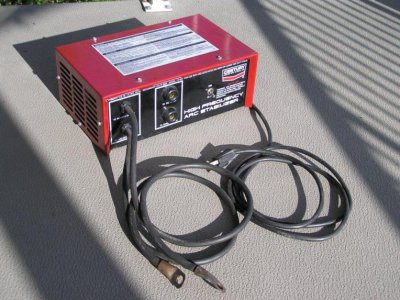- Joined
- Jun 17, 2011
- Messages
- 2,062
I picked up this Century HF Arc Stabilizer earlier this week at an estate sale. It is a Model 115-007. Output is 3500 volts and the unit is rated for a maximum welder output of 295 amps.

Has anyone had any experience with this type of equipment? I found the manual, but it consists of a few lines on connecting and a whole bunch of the usual dangers of welding, plus high voltage issues. I'm planning to use it with my Century 70 amp inverter or, to play with aluminum, a 90 amp transformer stick machine.
I have already made a module to provide post-flow argon timing when the arc is extinguished and can expand that to give a choice of continuous HF or start-only.
I've read references to adding capacitors between the supply welder and the HF unit to protect the supply. Do you have any links that go into detail? I imagine the cap would have to be able to handle 5 kV (3500 v x 1.414), but how much capacitance is required? There is no mention of the frequency for this particular unit, but I read a blurb on another one that said 20 kHz. Where is the capacitance connected? Across the output terminals of the welder?
Thanks for any help you can give me.
BTW, if you are using a scratch-type TIG setup, you can use a piece of tungsten clamped near your starting point to reduce or eliminate contamination caused by contacting the steel or aluminum work piece. Just scratch the torch tungsten against the clamped piece to start the arc.


Has anyone had any experience with this type of equipment? I found the manual, but it consists of a few lines on connecting and a whole bunch of the usual dangers of welding, plus high voltage issues. I'm planning to use it with my Century 70 amp inverter or, to play with aluminum, a 90 amp transformer stick machine.
I have already made a module to provide post-flow argon timing when the arc is extinguished and can expand that to give a choice of continuous HF or start-only.
I've read references to adding capacitors between the supply welder and the HF unit to protect the supply. Do you have any links that go into detail? I imagine the cap would have to be able to handle 5 kV (3500 v x 1.414), but how much capacitance is required? There is no mention of the frequency for this particular unit, but I read a blurb on another one that said 20 kHz. Where is the capacitance connected? Across the output terminals of the welder?
Thanks for any help you can give me.
BTW, if you are using a scratch-type TIG setup, you can use a piece of tungsten clamped near your starting point to reduce or eliminate contamination caused by contacting the steel or aluminum work piece. Just scratch the torch tungsten against the clamped piece to start the arc.

Last edited by a moderator:

